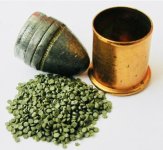I just bought a S&W Model 1 1/2 .32 RF (labeled as a 3rd issue by the store). #99690. It came with a box of Navy Arms .32 Long RF ammo (approx 33 rds). Great gun, but I'm wondering about the ammo. I never shoot ammo in an old gun unless I'm sure of what it is. The box says "Smokeless cartridges," which bugs me.
I'll probably break a cartridge down to check it out.
I like to fire a round or two from my antiques before I display them.
Ooops...I should have searched before posting. It's been covered before.
I'll probably break a cartridge down to check it out.
I like to fire a round or two from my antiques before I display them.
Ooops...I should have searched before posting. It's been covered before.
Last edited:


